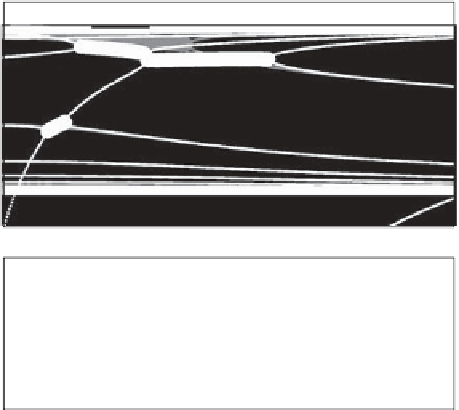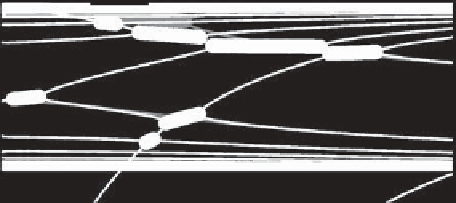Geoscience Reference
In-Depth Information
(a)
(b)
R
low
R
low
0
0
F
-0.2
-0.2
T
T
F
-0.4
-0.4
-0.6
-0.6
R
up
R
up
-0.8
-0.8
T
1
F
0.06
0.06
T
2
F
T
1
F
T
1
R
0.04
0.04
T
2
F
0.02
0.02
T
1
R
0
0
0
1
2
3
4
5
6
7
0
1
2
3
4
5
6
7
k
k
Figure 6.18.
Dispersion diagram (upper panel) and growth rate (lower panel) of the eigenmodes for: (a) Ro = 0.2 and To =
−
2
and (b) To =
5. Thick black lines in the upper panel correspond to the TF and TR resonances and respective unstable modes.
Gray lines in both panels correspond to the same case with no topography (Figure 6.10b).
−
(topography almost parallel to the interface). It is clear
from the expressions for the PV gradient in the lower layer,
parameters, both in the superrotating rigid-lid and free-
surface outcropping configurations, including topography
effects in the latter case. We got a detailed structure of
the unstable modes to be compared with the experimen-
tal results in these configurations. Such a comparison
shows a good agreement with the density-current exper-
iments. The experiments with two-layer fluid with super-
rotating lid do show the RK instability as follows from
the analysis of
Flór et al.
[2011], with good quantita-
tive agreement with two-layer shallow-water results, while
short-wave structures on the background of Rossby waves,
which were observed in experiments of
Williams et al.
[2005] and
Flór
[2007]), do not find a direct explana-
tion in terms of dominant unstable modes that we found.
This means that these short-wave structures are prob-
ably due to the fine vertical structure of the interface
between the layers, which does not exist in the shallow-
water approximation (see a discussion by
Flór et al.
[2011]
on this subject as well as Chapter 11 in this volume).
Our results on the influence of topography on the insta-
bilities show that in the case of opposite orientations
of the isopycnal and shelf slopes the destabilization of
density currents is due to resonances of Rossby and topo-
graphic waves, and thus the influence of topography may
be crucial.
f
∂
r
H
2
H
2
∂
r
Q
2
=
−
,
(6.19)
and for the topography parameter,
r
1
+
L
∂
r
H
t
∂
r
H
2
+
∂
r
H
t
To =
,
(6.20)
that To
→
1 will imply
∂
r
Q
2
→
0, which explains the
stabilization.
In Figure 6.18 we present the stability diagrams at two
different negative values of To at Ro = 0.2 showing
that the most unstable modes in such configurations are
due to the resonances of a frontal wave with a topo-
graphic wave (either the first
T
1
or the second
T
2
radial
mode), although the resonances of the first topographic
mode with a Rossby wave are also observed. Figure 6.19
displays the corresponding unstable modes. Thus, topog-
raphy plays a crucial role in the destabilization of the flow
in this regime.
6.5. SUMMARY AND DISCUSSION
We thus performed a stability analysis of the shear
flows in the rotating annulus in the framework of the
two-layer shallow-water model in the wide range of
Acknowledgments.
The work of V. Zeitlin was sup-
ported by the French ANR grant SVEMO.













































































